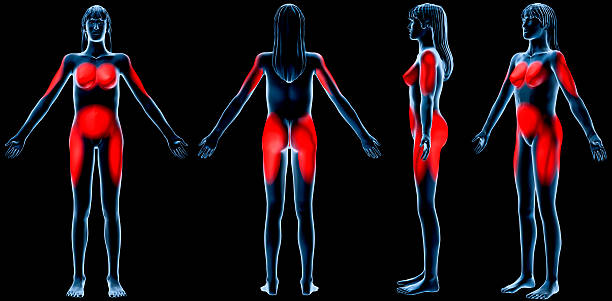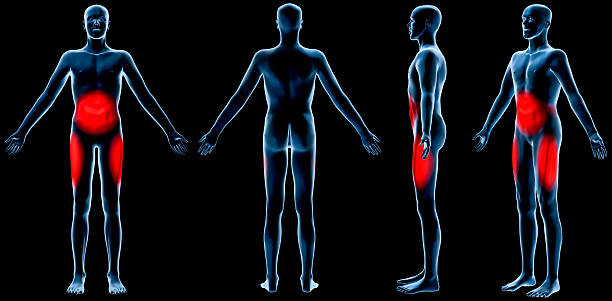“Excessive body fat stored around the stomach and abdomen is a key risk factor for weight-related disease”
Belly fat or ‘central adiposity’ to coin the scientific term is one of the unwelcome processes of ageing that is not only unsightly and uncomfortable for some but can also affect your hormone balance and lead to serious health conditions such as cardiovascular disease and diabetes.
Article Index:
For women experiencing the menopause the hormonal changes around this time lead to significant changes in fat distribution.
Typically fat tends to accumulate in adipose tissue around the middle rather than the hips, which is where the term ‘middle age spread’ comes from.
Adipose or fat tissue is composed primarily of fat cells (adipocytes), and is found mostly under the skin – this is called subcutaneous fat. It is also found around internal organs particularly those in the abdomen – known as visceral fat.
The accumulation of fat in adipose tissue is determined by the generation of fat versus the breakdown of fat and is responsive to changes in the diet. For example a high carbohydrate diet can elevate fatty acid levels whereas fasting is related to lower levels of fatty acids.
Abnormal fat accumulation around the waist has important implications for health; visceral fat – the type that builds up deep in the abdomen is considered to be more active and has specifically been linked to insulin resistance and type II diabetes.
Adipose tissue was once thought to be simply a passive storehouse for fat, which offered protection and insulation, but this is no longer the case.
Scientific understanding of the biochemistry of fat has increased substantially over the last few decades and it is now generally recognized that adipose tissue is a metabolically active organ that exerts an impact on the metabolism of the whole body and has a variety of diverse biological actions.
Functions of adipose tissue
-
Cushions and protects organs
Triglycerides, cholesterol and other essential fatty acids act as a cushion to protect tissues of the body against physical trauma. Many of the major organs are wrapped in a layer of visceral fat.
-
Insulates the body
Adipose tissue is an important heat insulator because it conducts heat less readily than other tissues – helping to maintain heat in the core organs.
-
Storage site for toxic substances
Adipose tissue can protect other tissues and organs by storing fat soluble toxic substances which are slowly released into the bloodstream and more so during weight loss. This presents a greater burden on the body for those with obesity.
-
Primary site for storage of surplus fuel
Adipose fat cells are specialized for storing energy in the form of fatty acids (triglycerides). An over consumption of carbohydrates – in excess of calories needed – results in the generation of fat which is stored in adipocytes as an energy reserve.
-
Acts as an endocrine organ
Regulates adipocyte activity – synthesizing and secreting hormones that influence a number of metabolic processes in other organ systems. Some of the hormones produced such as leptin, angiotensin and adiponectin influence sex hormone metabolism, insulin sensitivity, fat storage, blood pressure regulation, cell signalling and blood clotting.
Adiponectin has an influence on the brain to promote the breakdown of fat, raise metabolism and increase energy use in the muscles without affecting appetite. Overall these actions are able to reduce weight and lessen the risk of developing conditions such as heart disease and diabetes.
-
Secretes a number of substances
Including: growth factors, enzymes, structural proteins and immune system substances called cytokines – which in excess can lead to heart disease
Health dangers of increased abdominal fat
Visceral fat – more than any other type of fat is strongly linked with degenerative changes in the blood vessels that raise the risk of heart attacks and strokes.
Excessive fat around the abdomen is also linked to certain cancers, fertility problems and type II diabetes.
(female subcutaneousvisceral fat zones image)
One of the reasons visceral fat is believed to be so harmful is because it is located close to the portal vein, which transports blood from the area surrounding the intestines to the liver.
This blood carries substances released from visceral fat such as free fatty acids, which influence the production of blood lipids.
Research shows that visceral fat is strongly linked to insulin resistance as well as higher LDL (unhealthy cholesterol) and lower HDL (good cholesterol).
Scientists have learnt that abdominal fat can be dangerous when it becomes inflamed, furthermore research has shown that visceral fat releases a lot of inflammatory messengers into the body.
These are the culprits for raising blood pressure, influencing hormone balance, increasing the likelihood of blood clotting and interfering with the body’s ability to properly manage blood sugar levels.
Blood sugar levels are affected by the foods we eat – particularly carbohydrates and sugar.
These are broken down into glucose, which is absorbed into the blood and transported to the cells where it can be used for energy.
The hormone insulin controls blood sugar levels by chasing it into the cells. Sugar that is not needed is re-directed and stored as fat in adipocyte tissue.
Visceral fat can interfere with this process by releasing messengers that cause the cells to stop reacting to insulin.
This condition is known as insulin resistance and is linked to the development of type II diabetes. Insulin resistance means that your body’s muscle and liver cells don’t respond adequately to normal levels of insulin causing a rise in blood sugar levels.
Central obesity is therefore considered a risk factor.
(male subcutaneousvisceral fat zones image)
As well as muscle cells becoming resistant to insulin – fat cells can also stop responding normally to insulin, which has serious health implications.
If fat cells start to release fatty acids into the blood circulation, levels of triglycerides can become too high and this increases the risk for cardiovascular disease.
In addition to this, high levels of insulin promote the production of LDL cholesterol and lessen HDL cholesterol.
This combination can lead to a build up of fatty deposits that narrow the arteries and raise the risk of forming dangerous blood clots.
The combination of insulin resistance, central adiposity, abnormal blood fat levels, high blood pressure, inflammation and a susceptibility for blood clotting is termed metabolic syndrome or syndrome X. It is recognised that metabolic syndrome is a factor in the development of chronic disease.
It is worth noting that women with a waist circumference more than 35 inches and men with a waist circumference above 40 inches are at increased risk.
Why belly fat becomes more troublesome around the menopause
During the menopause it is quite common to experience an increase in abdominal or visceral fat which raises the risk of the associated health conditions.
Scientists suggest that visceral fat accumulates during the menopause due to an increase in the levels of free testosterone (this means it is not bound to sex hormone binding globulin).
This is thought to be caused by reduced levels of oestrogen that occur during the menopause and is linked to insulin resistance.
The changing levels in serotonin and oestrogen may also affect appetite control.
Positive lifestyle changes
In some cases genetics may play a role in the development of metabolic syndrome, but more often than not it is related to lifestyle choices.
This is easily remedied with some simple lifestyle changes – a healthy diet that aims to balance blood sugar levels and reduce visceral fat coupled with some well-chosen supplements.
This combination may be all that’s needed to prevent metabolic syndrome and its progression to serious health conditions.
Making these lifestyle changes can have a huge impact on your general sense of wellbeing so it’s worth putting in the effort. If you find the idea of changing everything all at once just too daunting, make a note in your diary to introduce one change a week.
-
Limit your intake of refined and sugary foods – these raise blood sugar levels and contribute to insulin resistance. The majority of your diet should be focussed on whole grain, unprocessed foods. Eat plenty of fresh fruit and vegetables and gradually introduce some ancient whole grains like quinoa, millet, buckwheat, wild rice, barley and spelt in place of white bread, pasta and rice.
-
Eat three main meals each day – include healthy fats such as flax, olive, coconut or hemp seed oil and lean protein (fish, poultry, beans and pulses) to slow down the rate at which glucose is taken into the bloodstream. Snack on fruit and a few nuts if you feel hungry between meals.
-
Swap sugar for Xylitol – it’s a natural sweetener sourced from Beech and Birch trees and contains less calories than sugar. It can also be used to bake with and won’t cause a rapid peak in blood sugar levels.
-
Avoid stimulants – alcohol, smoking and caffeine all cause a sharp rise in blood sugar levels, which may contribute to insulin resistance. Why not swap coffee for green tea, which may help burn off excess fat?
-
Get up and go! – Exercise helps to reverse insulin resistance and in particular targets visceral fat loss. Exercise can also help to counter some of the inflammatory effects of visceral fat.
-
Reduce stress – stress raises blood sugar levels, causes you to eat more than you need and makes you put on weight around the middle. Invest some time in meditation or yoga classes or try breathing exercises, research has shown these are effective ways of reducing stress and lowering blood pressure.
Supplements to support metabolic balance
Essential fatty acids – oils, such as those found in flax seeds, hemp seeds and oily fish, can help cells to respond better to insulin, encourage fat burning and maintain cholesterol balance.
CLA (Conjugated linoleic Acid) – works to decrease the number and size of adipocytes when used in conjunction with regular exercise
Chromium – studies suggest that chromium helps increase insulin sensitivity in the cells as well as aiding blood sugar balance and weight loss.
Magnesium and zinc – both these minerals are essential for proper insulin response and management of blood sugar levels. Unfortunately, many people have depleted levels of these important minerals due to poor dietary intake and stressful lifestyles.
B vitamins – stress and high blood sugar levels rapidly deplete B vitamin in the body, but each and every cell, in order to burn glucose and fat properly, needs them.
Acetyl l carnitine – is needed to transport fat into the mitochondria of our cells. These help the body to burn fat for energy.
Cinnamon – helps keep blood sugar levels stable, reduce sweet cravings and curb appetite.
American Ginseng – has been found to significantly reduce blood sugar levels after meals. It also helps to reduce the effects of stress, which generally increases blood sugar levels.
Fenugreek – can help to maintain healthy blood sugar levels and may be helpful for increasing the sensitivity of cells to insulin.
Catch up with the rest of the ‘hormone’ email series:
Written by: Jacqueline Newson BSc (Hons) Nutritional Therapy











